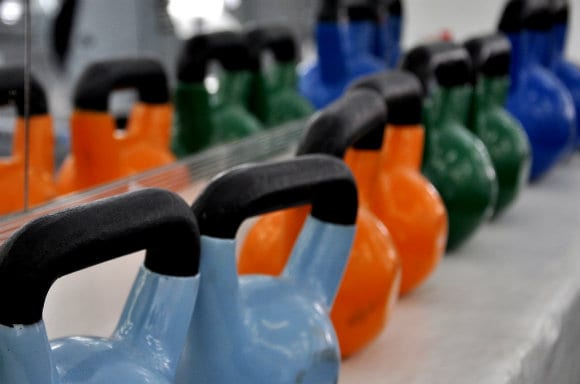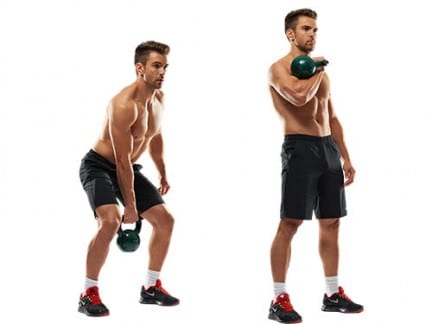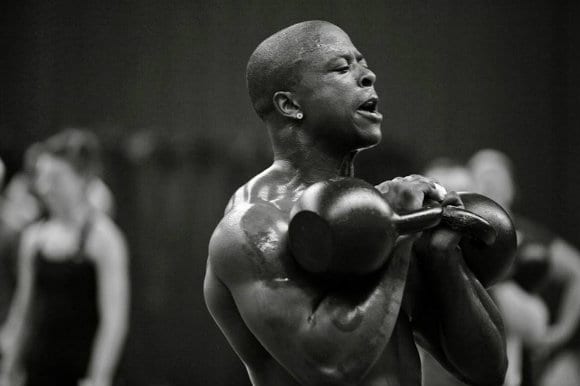By the healthiergang writer Gabriele Galasso, Functional Training instructor and K1 competitive athlete.
Clean Con Kettlebell
The kettlebell (or ghiria) is a fantastic and versatile tool, formed by a cast iron sphere with a handle, which has its origins in Russia.
It is said that Tsar Alexander III, on the occasion of a train accident, after having saved his life and that of his family thanks to the strength acquired with their use, made the use of this tool mandatory in the hours of physical education.
After being exported to America, the use of the kettlebell spread like wildfire thanks also to the customs clearance of functional training.
Commercially they can be found in different sizes which in the most common cases range between 4 and 36 kilograms (there are also heavier ones).
How is it done? Variants
The clean is the basic movement with which we often bring ourselves to the starting position of many exercises such as the press or the goblet squat, and can be performed in 3 variations:
- to a one-handed kettlebell
- to a two-handed kettlebell
- two-handed kettlebells

NB: a main distinction I make upstream is that between death clean and clean: the substantial difference lies in the start, which in the dead clean starts with the kettlebell on the ground as for a deadlift, while in the clean, the start is always a swing (read the article dedicated to swing to learn more).
In this article, therefore, I already anticipate that we will deal with the first version or the deadclean.
Regardless of the version, in general, the clean if well performed involves the involvement of a large part of the muscles of the upper part and the core (trapezius, deltoids, biceps, parascapular and paravertebral).
Furthermore, being a particularly training exercise for the hip extensor chain it is very suitable for all those sports whose gestures depend a lot on this kinematics, such as combat sports.
1. Two-handed Kettlebell
This is perhaps the simplest version, and mainly involves these phases:
- Start in a standing position with feet shoulder-width apart and toes pointing some degree outwards. The kettlebell is placed on the ground under our pelvis
- Fixing a point a few meters from us in order not to lose physiological curves, flex the hip (without bringing the shoulders forward, but pushing the hips back) and grab the kettlebell with both hands keeping the elbows close to the torso.
- By activating the latissimus and keeping the weight on the heels, straighten the hip making sure that the knees do not close inwards.The most common mistake in this phase is to lift the kettlebell with the use of the lumbar and not with the press. hip; a good abdominal contraction should help ward off this danger.
- During the journey the kettlebell must rise towards the chest along a straight line perpendicular to the ground and not following curved trajectories.
- Lock the kettlebell in the rack position with the elbows not detached from the torso and the legs fully extended, activating the glutes and abdomen.
2. One-handed Kettlebell
Version ch provides a substantially similar movement performed with 1 kettlebell in one hand, which provides similar mechanics but not identical to the version described above, starting from the final position.
- Start in a standing position with feet shoulder-width apart and toes pointing some degree outwards. The kettlebell is placed on the ground under our pelvis.
- By fixing a point a few meters away from us in order not to lose physiological curves, flex the hip (without bringing the shoulders forward, but pushing the hips back) and grab the kettlebell with one hand trying not to misalign the shoulders (as if we wanted to. grasp with both hands). The non-grasping hand can move outward to the ipsilateral knee or forward.
- Activating the latissimus and keeping the weight on the heels, and the elbow close to the body, straighten the hip making sure that the knees do not close inward. The most common mistake in this phase is to lift the kettlebell with the use of the lumbar and not with the extension of the hip; a good abdominal contraction should help ward off this danger. Usually in this phase the elbow can detach from the torso for a few moments, and then come closer in the final closing phase.
- Trying not to involve the muscles of the affected arm, move to the final position of the figure, with the elbow always adherent to the torso, contracting the buttocks and abdomen, and letting the kettlebell wrap without hitting around the wrist (it takes a lot of practice to assimilate this technique, so leave with a manageable load: an observation on the load is that for a neophyte it must not be too heavy but not too light, otherwise you risk not being able to perceive the need to push the hip as the instrument would move quietly using only the arm muscles) .

3. Two two-handed kettlebells
Double kettlebell version of the previous exercise, which follows the same mechanics.
- Starting in a standing position with the feet slightly wider than the shoulders (due to the presence of two kettlebells instead of one), with the instruments resting on the ground under the pelvis
- By fixing a point a few meters away from us so as not to lose the physiological curves, flex the hip (without bringing the shoulders forward, but pushing the hips back) and grab the kettlebells.
- Activating the latissimus and keeping the weight on the heels, stretch the hip forcefully by pulling the kettlebells upwards and trying to keep the elbows close to the body (the elbows will tend to come off during the shrug phase but must quickly close immediately afterwards) .
- By contracting the buttocks and abdomen and exhaling forcefully (retaining about 30% of the air in the lungs) close the repetition in rack position, with the elbows forming an interlocking with the torso to accommodate the ghirie assuming the position of figure 4 .

Conclusions
In light of this general smattering of dead clean (there is much more to say and the advice is always to rely on a certified trainer to learn the technique) it can be concluded that it is a highly conditioning exercise for the whole body, especially for the upper part.
Performed with not very high loads for timed circuits, it is very suitable for the general conditioning of each athlete, but it can also be inserted in cards for the development of strength especially if important loads are brought into play.
Now you just have to get yourself a kettlebell (or two) and have fun by incorporating this fabulous exercise into your workouts!


























